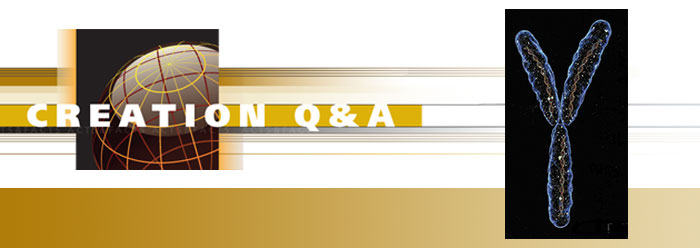Secular geneticists believe that modern humans can trace their male genetic ancestry back to one man and their female genetic ancestry back to one woman.1 Two new studies suggest that female “mitochondrial Eve” and male “Y-chromosome Adam” lived a couple hundred thousand years ago. However, the assumptions researchers used to reach this dating concordance demonstrate the circular reasoning that is common in evolutionary age calculations.
Reviewing some basic genetics helps expose this circularity. Each person inherits two copies of the approximately three billion chemical “letters” (DNA sequence) of the human genome—one copy from each parent for a total of six billion letters. However, offspring do not inherit perfect copies. Mutations—changes to the sequence—happen every generation. The accumulation of these differences resembles “ticks” of a clock, counting the time since any two people last shared a common sequence. In principle, winding back the clock might reveal the approximate date when their shared ancestor lived. However, most of the billions of letters of DNA sequence do not act like simple clocks. Only two types of DNA sequences could act, hypothetically, like a simple clock—the male-specific Y-chromosome DNA and the maternally inherited mitochondrial DNA.
Calculating the date of origin for the ancestors of modern Y chromosomes and mitochondrial DNA might seem straightforward: First, simply count the number of Y-chromosome differences among all males and the number of mitochondrial differences among all females. Second, measure the rate of mutational change that is occurring today. And last, make assumptions about the rate of change in the past and calculate when the mutational clock started ticking. But past studies yielded vastly different age estimates for the origin of modern males and females. Recently, Science published two studies that obtained many more Y chromosome sequences, bringing the formerly discordant results into general agreement with an origin date of 120,000 to 200,000 years ago.2, 3
However, this new “agreement” does not disprove the origin of Adam and Eve as occurring roughly 6,000 years ago, because these studies were grounded in a set of invalid assumptions. For example, rather than directly measuring mutation rates in various ethnicities, the authors assumed a constant rate across ethnicities. Previously published research undermines this assumption.4
The authors also assumed a constant rate of change through time. Yet, the environmental changes associated with the Flood of Noah (e.g., possible accelerated radiometric decay) may have affected the rates of DNA change.5 Furthermore, in the approximately 4,000 years that have elapsed since the Flood, why should we assume that the human genetic mutation rate has been uniform?
Finally, the authors calibrated their molecular data to archaeological “dates.” These age assignments depend on notoriously unreliable radiometric dating techniques and thus are not independent validations for the molecular data.5
All molecular-clock calculations require the observer to speculate about the past, and the Science study authors selected assumptions based on their model of evolutionary deep time, resulting in circular reasoning. Clearly, the hundred-thousand-year dates for “Y-chromosome Adam” and “mitochondrial Eve” do not bear up under careful scrutiny.
References
- Evolutionists do not believe in a literal Adam or Eve. Rather, they claim that modern humans descended from a population of ancestors over the last several hundred thousand years. These two statements may seem at odds, but population genetics permits this seeming contradiction. The background calculations lie beyond the scope of the present article.
- Poznik, G. D. et al. 2013. Sequencing Y Chromosomes Resolves Discrepancy in Time to Common Ancestor of Males Versus Females. Science. 341 (6145): 562-565.
- Francalacci, P. et al. 2013. Low-Pass DNA Sequencing of 1200 Sardinians Reconstructs European Y-Chromosome Phylogeny. Science. 341 (6145): 565-569.
- Conrad, D. F. et al. 2011. Variation in genome-wide mutation rates within and between human families. Nature Genetics. 43 (7): 712–714.
- Vardiman, L., A. A. Snelling and E. F. Chaffin, eds. 2005. Radioisotopes and the Age of the Earth: Results of a Young-Earth Creationist Research Initiative. El Cajon, CA: Institute for Creation Research, and Chino Valley, AZ: Creation Research Society.
* Dr. Jeanson is Deputy Director for Life Sciences Research and received his Ph.D. in cell and developmental biology from Harvard University.




















